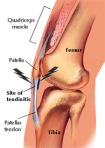All too often medicines have harmful side-effects. Vioxx and Bextra, previously common NSAID’s, were taken off the market because of serious side-effects. Medicines can have harmful effects on patient cardiovascular, pulmonary and GI system.
Can medicines have an effect of stem cell production?
Deng et al, demonstrated that aspirin inhibits stem cell growth.
Regenerative Sciences understands the importance of medication on mesenchymal stem cell production. Patients that undergo the Regenexx procedure for orthopedic applications are counseled about the impact that specific medications have on stem cell production. One of the many medications which is restricted is aspirin.


 Tendons are fibrous connective tissue that attach a muscle to bone.
Tendons are fibrous connective tissue that attach a muscle to bone.



